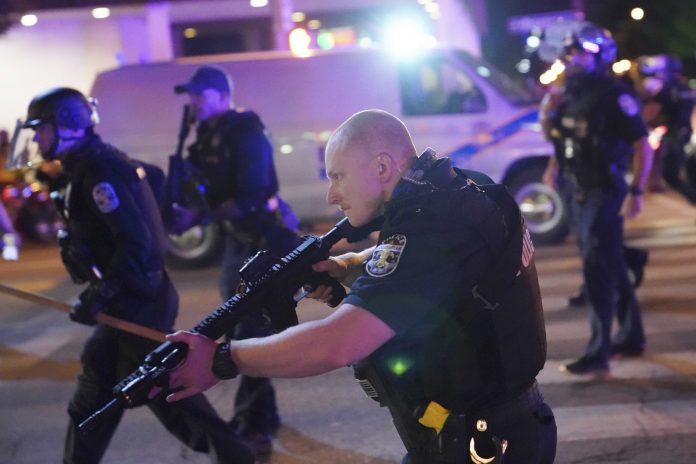
By MICHAEL BALSAMO
Associated Press
WASHINGTON (AP) — The federal government should study how police use less-lethal weapons, like tear gas and bean-bag guns, and offer guidance to law enforcement agencies across the U.S. because officers are often left with little information beyond the manufacturer’s guidelines, according to a new report by one of the country’s leading police research groups.
The report — being released Friday by the Police Executive Research Forum, an organization dedicated to improving the professionalism of policing — examines how police departments handled the thousands of protests and civil unrest in the U.S. in the summer of 2020, after George Floyd was killed at the hands of officers in Minneapolis.
The report offers 38 recommendations for police departments about how to handle demonstrations, civil disturbances and the violence that occurred during the unrest. It is based on interviews with police chiefs, reviews of after-action reports and an analysis of intelligence and other police reports. The recommendations include improving training, avoiding mass arrests, improving communication both internally within police forces and to the community during demonstrations and conducting robust reviews after large-scale protests.
But the report also examines the use of less-lethal weapons and points specifically to the need to study their use and for police forces to have a playbook to follow – something the report notes has been sorely lacking for years. Now, the group is recommending the Justice Department’s research arm, the National Institute of Justice, begin examining their use and offer resources to law enforcement agencies about when and how to use the weapons.
The use of such weapons, like tear gas, pepper balls, flash bangs and smoke bombs, became a flashpoint in the debate over policing in 2020 after dozens of incidents of protesters and members of the media being struck by projectiles or caught up in clouds of tear gas unleashed on mostly peaceful crowds.
Tear gas has commonly been used as a defensive tool by law enforcement to make rioters disperse. But during the nationwide protests in 2020, federal, state and local law enforcement agencies sometimes used it offensively and in some cases directed it at large crowds with peaceful protesters, as opposed to individual people committing violence.
“All of those kinds of things, pepper spray, CS gas, bean-bag rounds, rubber bullets, in many cases, departments had not used that kind of equipment in some time,” said Chuck Wexler, the executive director of the Police Executive Research Forum. “And the key part of it is, in the after-action reports, significant concern about how and when the police deployed these less-lethal weapons.”
The group started to examine whether there were guidelines or standards for the use of less-lethal weapons, and while some police departments have developed their own policies around when to use such force, many are left with only the manufacturer’s guidelines, Wexler said.
The report recommends the National Institute of Justice “conduct significant research on this to determine the limitations and best practices of this kind of equipment,” he said.
“There is no there is no playbook that exists today for American police in using this kind of equipment,” he said.
In city after city, police chiefs reported that as protests grew, they were seeing something they had not seen in decades of handling protests – by day, the crowds were huge but largely peaceful and at night, there was a significant escalation in violence during the demonstrations.
During the demonstrations, protesters and others reported serious injuries after police used less-lethal weapons on crowds, including broken bones, traumatic brain injuries and temporary blindness after being struck by projectiles fired by officers.
A photographer covering a protest in Minneapolis was blinded in one eye after being shot in the face by a rubber bullet. A television reporter in Louisville, Kentucky, was hit by a pepper ball on live television by an officer who appeared to be aiming at her. The Justice Department has since launched sweeping civil rights investigations to examine the practices of the Minneapolis and Louisville police departments, including their response to protests.
Police officers across the country were also injured when they were hit by bottles, rocks, bricks and cans of soup that were hurled at them in crowds.
The report also notes that even so-called soft projectiles “can cause serious or even fatal injuries, and can be difficult to target.”
The report also recommends that police provide clearer directions for protesters when ordering them to disperse from an area. In addition to providing advance notice that they will be using force, the report advises police to give specific directions, like ordering protesters to exit onto particular streets or leave a park through a certain exit, along with a deadline.
In Lafayette Square, outside the White House, protesters who were forcefully removed by police before then-President Donald Trump walked to a church near the White House for a photo op, reported they did not hear U.S. Park Police order them to disperse before federal officers unleashed a flurry of smoke bombs and pepper balls on the peaceful crowd.
Wexler said he has spoken with Associate Attorney General Vanita Gupta, who oversees of a slew of Justice Department offices, including the National Institute of Justice, and that she was receptive to the recommendation and said examining these issues is a priority for the Justice Department.
The Justice Department did not make Gupta available for an interview.



















